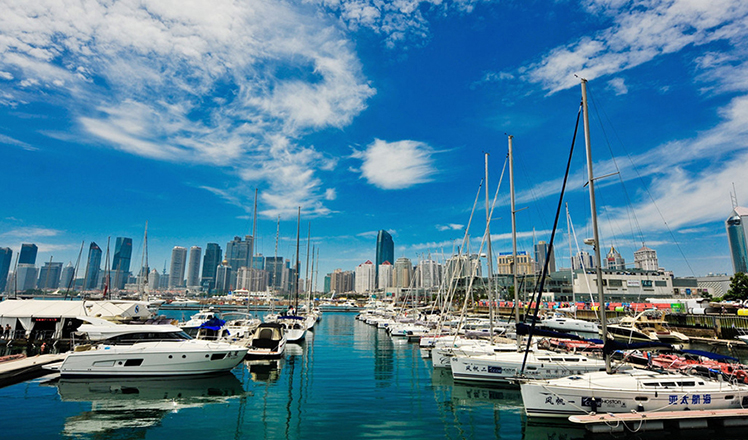History and law back China's sovereignty
Updated: 2016-07-14 07:51
(China Daily)
|
|||||||||
12. Some of the names given by the Chinese people to Nanhai Zhudao were adopted by Western navigators and marked in some authoritative navigation guidebooks and charts published in the 19th and 20th centuries. For instance, Namyit (Hongxiu Dao), Sin Cowe (Jinghong Dao) and Subi (Zhubi Jiao) originate from "Nanyi", "Chenggou" and "Chouwei" as pronounced in Hainan dialects.
13. Numerous historical documents and objects prove that the Chinese people have explored and exploited in a sustained way Nanhai Zhudao and relevant waters. Starting from the Ming and Qing Dynasties, Chinese fishermen sailed southward on the northeasterly monsoon to Nansha Qundao and relevant waters for fishery production activities and returned on the southwesterly monsoon to the mainland the following year. Some of them lived on the islands for years, going for fishing, digging wells for fresh water, cultivating land and farming, building huts and temples, and raising livestock. Chinese and foreign historical literature as well as archaeological finds show that there were crops, wells, huts, temples, tombs and tablet inscriptions left by Chinese fishermen on some islands and reefs of Nansha Qundao.
14. Many foreign documents also recorded the fact that during a long period of time only Chinese lived and worked on Nansha Qundao.
15. The China Sea Directory published in 1868 by order of the Lords Commissioners of the Admiralty of the United Kingdom, when referring to Zhenghe Qunjiao of Nansha Qundao, observed that "Hainan fishermen, who subsist by collecting trepang and tortoise-shell, were found upon most of these islands, some of whom remain for years amongst the reefs", and that "[t]he fishermen upon Itu-Aba island[Taiping Dao] were more comfortably established than the others, and the water found in the well on that island was better than elsewhere." The China Sea Directory published in 1906 and The China Sea Pilot in its 1912, 1923 and 1937 editions made in many parts explicit records of the Chinese fishermen living and working on Nansha Qundao.
16. The French magazine Le Monde Colonial Illustré published in September 1933 contains the following records: Only Chinese people (Hainan natives) lived on the nine islands of Nansha Qundao and there were no people from other countries. Seven were on Nanzi Dao (South West Cay), two of them were children. Five lived on Zhongye Dao (Thitu Island); four lived on Nanwei Dao (Spratly Island), one person more over that of 1930. There were worship stands, thatched cottages and wells left by the Chinese on Nanyao Dao (Loaita Island). No one was sighted on Taiping Dao (Itu Aba Island), but a tablet scripted with Chinese characters was found, which said that, in that magazine's rendition, "Moi, Ti Mung, patron de jonque, suis venu ici à la pleine lune de mars pour vous porter des aliments. Je n'ai trouvé personne, je laisse le riz à l'abri des pierres et je pars." Traces were also found of fishermen living on the other islands. This magazine also records that there are abundant vegetation, wells providing drinking water, coconut palms, banana trees, papaya trees, pineapples, green vegetables and potatoes as well as poultry on Taiping Dao, Zhongye Dao, Nanwei Dao and other islands, and that these islands are habitable.
17. Japanese literature Boufuu No Shima (Stormy Island) published in 1940 as well as The Asiatic Pilot, Vol. IV, published by the United States Hydrographic Office in 1925 also have accounts about Chinese fishermen who lived and worked on Nansha Qundao.
18. China is the first to have continuously exercised authority over Nanhai Zhudao and relevant maritime activities. In history, China has exercised jurisdiction in a continuous, peaceful and effective manner over Nanhai Zhudao and in relevant waters through measures such as establishment of administrative setups, naval patrols, resources development, astronomical observation and geographical survey.
19. For instance, in the Song Dynasty, China established a post of Jing Lüe An Fu Shi (Imperial Envoy for Management and Pacification) in the regions now known as Guangdong and Guangxi to govern the southern territory. It is mentioned in Zeng Gongliang's Wujing Zongyao (Outline Record of Military Affairs) that, in order to strengthen defense in the South China Sea, China established naval units to conduct patrols therein. In the Qing Dynasty, Ming Yi's Qiongzhou Fuzhi (Chronicle of Qiongzhou Prefecture), Zhong Yuandi's Yazhou Zhi (Chronicle of Yazhou Prefecture) and others all listed "Shitang" and "Changsha" under the items of "maritime defense".
20. Many of China's local official records, such as Guangdong Tong Zhi (General Chronicle of Guangdong), Qiongzhou Fu Zhi (Chronicle of Qiongzhou Prefecture) and Wanzhou Zhi (Chronicle of Wanzhou), contain in the section on "territory" or "geography, mountains and waters" a statement that "Wanzhou covers 'Qianlichangsha' and 'Wanlishitang'" or something similar.
21. The successive Chinese governments have marked Nanhai Zhudao as Chinese territory on official maps, such as the 1755 Tian Xia Zong Yu Tu (General Map of Geography of the All-under-heaven) of the Huang Qing Ge Zhi Sheng Fen Tu (Map of the Provinces Directly under the Imperial Qing Authority), the 1767 Da Qing Wan Nian Yi Tong Tian Xia Tu (Map of the Eternally Unified All-under-heaven of the Great Qing Empire), the 1810 Da Qing Wan Nian Yi Tong Di Li Quan Tu (Map of the Eternally Unified Great Qing Empire) and the 1817 Da Qing Yi Tong Tian Xia Quan Tu (Map of the Unified All-underheaven of the Great Qing Empire).
22. Historical facts show that the Chinese people have all along taken Nanhai Zhudao and relevant waters as a ground for living and production, where they have engaged in exploration and exploitation activities in various forms. The successive Chinese governments have exercised jurisdiction over Nanhai Zhudao in a continuous, peaceful and effective manner. In the course of history, China has established sovereignty over Nanhai Zhudao and relevant rights and interests in the South China Sea. The Chinese people have long been the master of Nanhai Zhudao.
ii. China has always been resolute in upholding its territorial sovereignty and maritime rights and interests in the South China Sea
23. China's sovereignty over Nanhai Zhudao had never been challenged before the 20th century. When France and Japan invaded and illegally occupied by force some islands and reefs of China's Nansha Qundao in the 1930s and 1940s, the Chinese people rose to fight back strenuously and the Chinese government took a series of measures to defend China's sovereignty over Nansha Qundao.
24. In 1933, France invaded some islands and reefs of Nansha Qundao and declared "occupation" of them in an announcement published in Journal Officiel, creating the "Incident of the Nine Islets". The French aggression triggered strong reactions and large scale protests from all walks of life across China. The Chinese fishermen living on Nansha Qundao also took on-site resistance against the French aggression. Chinese fishermen Fu Hongguang, Ke Jiayu, Zheng Landing and others cut down the posts flying French flags on Taiping Dao, Beizi Dao, Nanwei Dao, Zhongye Dao and others.
25. Shortly after this Incident happened, the Chinese Ministry of Foreign Affairs made clear through its spokesperson, referring to the relevant islands of Nansha Qundao, that "no other people but Chinese fishermen live on the islands and they are recognized internationally as Chinese territory". The Chinese government made strong representations to the French government against its aggression. And in response to the French attempt to trick Chinese fishermen into hanging French flags, the government of Guangdong Province instructed that administrators of all counties should issue public notice forbidding all Chinese fishing vessels operating in Nansha Qundao and relevant waters from hanging foreign flags, and Chinese national flags were distributed to them to be hung on Chinese fishing vessels.
26. China's Committee for the Examination for the Land and Sea Maps, which was composed of representatives of the Ministry of Foreign Affairs, Ministry of the Interior, Ministry of the Navy and other institutions, reviewed and approved the names of individual islands, reefs, banks and shoals of Nanhai Zhudao, compiled and published Zhong Guo Nan Hai Ge Dao Yu Tu (Map of the South China Sea Islands of China) in 1935.
27. Japan invaded and illegally occupied Nanhai Zhudao during its war of aggression against China. The Chinese people fought heroically against the Japanese aggression. With the advance of the World's Anti-Fascist War and the Chinese People's War of Resistance against Japanese Aggression, China, the United States and the United Kingdom solemnly demanded in the Cairo Declaration in December 1943 that all the territories Japan had stolen from the Chinese shall be restored to China. In July 1945, China, the United States and the United Kingdom issued the Potsdam Proclamation. That Proclamation explicitly declares in Article 8: "The terms of the Cairo Declaration shall be carried out."
28. In August 1945, Japan announced its acceptance of the Potsdam Proclamation and its unconditional surrender. In November and December 1946, the Chinese government dispatched Colonel Lin Zun and other senior military and civil officials to Xisha Qundao and Nansha Qundao to resume exercise of authority over these Islands, with commemorative ceremonies held, sovereignty markers re-erected, and troops garrisoned. These officials arrived at these islands on four warships, namely Yongxing, Zhongjian, Taiping and Zhongye. Subsequently, the Chinese government renamed four islands of Xisha Qundao and Nansha Qundao after the names of those four warships.
- Arbitration body 'has nothing to do' with us, says UN
- Trump expected to make VP announcement on Friday
- 25 killed, 50 injured as trains collide in Italy
- The South China Sea Arbitration: Illegal, Illegitimate and Invalid
- Theresa May set to be UK's next Prime Minister after rival stands down
- Killing of UN Chinese peacekeepers slamed

 Coming-of-Age Day on the frontline of fighting floods
Coming-of-Age Day on the frontline of fighting floods
 Monks seek tranquility inside lotus ponds
Monks seek tranquility inside lotus ponds
 In pics: Top 10 livable Chinese cities
In pics: Top 10 livable Chinese cities
 Restaurant of 'bandits' opens in Northeast China's Jilin
Restaurant of 'bandits' opens in Northeast China's Jilin
 Ivanovic, Schweinsteiger holds wedding in Venice
Ivanovic, Schweinsteiger holds wedding in Venice
 Tim Duncan announces retirement after 19 seasons with Spurs
Tim Duncan announces retirement after 19 seasons with Spurs
 Merchandize for Rio 2016 a hit in run-up to games
Merchandize for Rio 2016 a hit in run-up to games
 Top 10 best Chinese cities to own a house
Top 10 best Chinese cities to own a house
Most Viewed
Editor's Picks

|

|

|

|

|

|
Today's Top News
Ministry slams US-Korean THAAD deployment
Two police officers shot at protest in Dallas
Abe's blame game reveals his policies failing to get results
Ending wildlife trafficking must be policy priority in Asia
Effects of supply-side reform take time to be seen
Chinese State Councilor Yang Jiechi to meet Kerry
Chinese stocks surge on back of MSCI rumors
Liang avoids jail in shooting death
US Weekly

|

|









